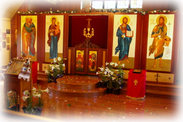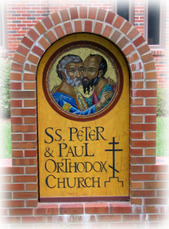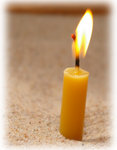Interested in visiting Saints Peter and Paul?
|
Here are answers to a few questions frequently asked by visitors new to Orthodoxy and Orthodox worship services. We hope they make your first visit more comfortable.
|
When and how long are the services?
- Saturday Evening Great Vespers (evening prayers) start at 5:45pm and generally last about 45 minutes.
- Orthros or Matins (Morning prayers) begin on Sunday mornings at 9:00am and last for about an hour.
- Divine Liturgy follows the Orthros service at 10am and lasts approximately 90 minutes.
- Other Great Vespers and Divine Liturgies during the week generally are about an hour in length.
The Sunday Divine Liturgy Service

When you enter our church you enter the church Narthex. As you turn to the left through the double doors you enter the church Nave, the sacred space where the congregation worships.
Our normal Sunday service is the Divine Liturgy of Saint John Chrysostom. If you wish to follow along, the text of the service is in the books in the pews. Or, if you prefer, you may simply close your eyes and enter into the Church’s beautiful worship of God. We think that when you have participated in an Orthodox service you will feel like – as one visitor put it – “you have truly worshipped the living God”.
Immediately following the Sunday Divine Liturgy, you are invited to join us for a “coffee hour” which is a good time to get to know our parish members and meet Fr. Nikolai, our priest! If you are not interested in social interaction at first, that’s fine! You are always welcome to follow at your own pace and level of interest!
Our normal Sunday service is the Divine Liturgy of Saint John Chrysostom. If you wish to follow along, the text of the service is in the books in the pews. Or, if you prefer, you may simply close your eyes and enter into the Church’s beautiful worship of God. We think that when you have participated in an Orthodox service you will feel like – as one visitor put it – “you have truly worshipped the living God”.
Immediately following the Sunday Divine Liturgy, you are invited to join us for a “coffee hour” which is a good time to get to know our parish members and meet Fr. Nikolai, our priest! If you are not interested in social interaction at first, that’s fine! You are always welcome to follow at your own pace and level of interest!
Is there a dress code?
The general rule for men and women is to dress appropriately, modestly and respectfully, as before the living God.
Visitors wear everything from jeans to suits, long dresses to skirts, tee shirts to shirts with ties, dress shoes to sneakers. We ask, however, that you not wear shorts, mini-skirts, tank tops, low-cut or strapless dresses (unless covered by a sweater, etc.). Some Orthodox women wear head coverings, but this is not required. Men are asked not to wear head coverings (baseball caps, etc.) in the Nave.
Visitors wear everything from jeans to suits, long dresses to skirts, tee shirts to shirts with ties, dress shoes to sneakers. We ask, however, that you not wear shorts, mini-skirts, tank tops, low-cut or strapless dresses (unless covered by a sweater, etc.). Some Orthodox women wear head coverings, but this is not required. Men are asked not to wear head coverings (baseball caps, etc.) in the Nave.
Is childcare provided?
Each parent is responsible to take care of their children. During services, nursing mothers usually go back to the Narthex when it is time to nurse their babies.
We encourage children to be present in Church for the services. This participation is part of a child’s spiritual formation. However, if your baby or child gets fussy, talkative, or has a melt-down, please take him or her out of the Nave until he or she is ready to return quietly!
There is also a nursery and play room in the basement which is available for use. During services a loudspeaker is on so you can hear the service in the basement.
We encourage children to be present in Church for the services. This participation is part of a child’s spiritual formation. However, if your baby or child gets fussy, talkative, or has a melt-down, please take him or her out of the Nave until he or she is ready to return quietly!
There is also a nursery and play room in the basement which is available for use. During services a loudspeaker is on so you can hear the service in the basement.
Is Sunday School available for children?
During school months, we provide Sunday School for children pre-school age through the sixth grade. Sunday school is held in the basement of the Church during Orthros (9:00am – 10:00am).
Standing or sitting?
The traditional posture for prayer and worship in the Orthodox Church is to stand, as before the King of the universe! In the Orthodox “old countries” there are typically no pews in the churches and you will notice we have a limited number in our Nave. Chairs or benches on the side walls are usually reserved for the elderly and infirm.
In North America we tend to build our churches with pews or chairs. So you are free to sit! However, there are a few times it is appropriate to stand: during the Gospel reading, the Little and Great Entrances, the distribution of Holy Communion, when the priest gives a blessing, and at the Dismissal. Just follow the congregation!
In North America we tend to build our churches with pews or chairs. So you are free to sit! However, there are a few times it is appropriate to stand: during the Gospel reading, the Little and Great Entrances, the distribution of Holy Communion, when the priest gives a blessing, and at the Dismissal. Just follow the congregation!
|
Can non-Orthodox receive the Holy Eucharist?
Orthodox priests may only serve the Holy Eucharist to baptized members in good standing of the canonical Orthodox Church, who have recently confessed, and fasted before partaking of the Holy Eucharist.
This is the ancient tradition of the Holy Church for the 2,000 years of its history. The Orthodox Church understands the Holy Eucharist as a mystery of the real presence of Christ in the Eucharist, not simply as a memorial, or merely in a spiritual sense, as many other non-Orthodox Christians do.
Rather than trying to accommodate too often varying “interpretations” or revisions of this and other doctrines of the ancient faith, we simply ask that you respect the ancient, apostolic tradition and join us in receiving the Fellowship bread at the veneration of the cross, at the end of the Divine Liturgy.
This is the ancient tradition of the Holy Church for the 2,000 years of its history. The Orthodox Church understands the Holy Eucharist as a mystery of the real presence of Christ in the Eucharist, not simply as a memorial, or merely in a spiritual sense, as many other non-Orthodox Christians do.
Rather than trying to accommodate too often varying “interpretations” or revisions of this and other doctrines of the ancient faith, we simply ask that you respect the ancient, apostolic tradition and join us in receiving the Fellowship bread at the veneration of the cross, at the end of the Divine Liturgy.
What is Orthodox worship music like?
Close to seventy-five percent of an Orthodox service is congregational singing. Traditionally, Orthodox do not use instruments. Usually a choir leads the people in a capella harmony, with the level of congregational response varying from parish to parish. At Saints Peter and Paul you are encouraged to sing along with the choir as you are able to.
The style of music varies as well, from very traditional Byzantine-sounding chant in some parishes, to more Western-sounding four-part harmony in a Russian church, with lots of variation in between. The music is solemn, prayerful, joyful at times and is intended to lead the faithful to worship the living God.
The style of music varies as well, from very traditional Byzantine-sounding chant in some parishes, to more Western-sounding four-part harmony in a Russian church, with lots of variation in between. The music is solemn, prayerful, joyful at times and is intended to lead the faithful to worship the living God.
Here are four brief excerpts from music you might hear during a service at Saints Peter and Paul:
|
|
|
|
As a new visitor you will find there are many new things to experience in a Holy Orthodox Church service! Feel free to go at your own pace, ask any questions you want, and know you are most welcome to “come and see”!
Don’t be afraid to ask questions about what we do and why (at the appropriate time, of course!)! Our small bookstore also has books and pamphlets that can help answer a variety of questions. Subjects include Christian church history, theology, catechism, Orthodox spirituality, inspiration, prayer, the lives of the Saints, and stories about others who have journeyed to the Orthodox Faith.
Don’t be afraid to ask questions about what we do and why (at the appropriate time, of course!)! Our small bookstore also has books and pamphlets that can help answer a variety of questions. Subjects include Christian church history, theology, catechism, Orthodox spirituality, inspiration, prayer, the lives of the Saints, and stories about others who have journeyed to the Orthodox Faith.

